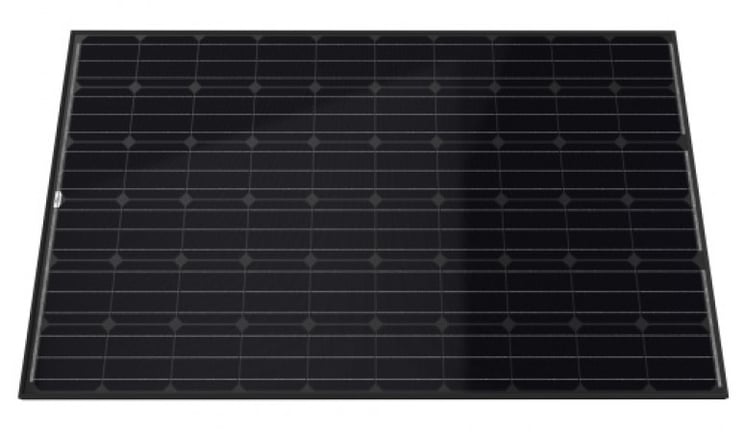Solar panel key parameters
If you are trying to compare one PV panel to another, it is helpful to understand the key technical parameters - or solar panel specifications - that impact performance.
With this in mind, we’ve taken some extracts from the specification sheet for a standard polycrystalline solar panel (Trina Solar’s HoneyM Plus+ 265-275W range) and highlighted the key parameters.
We’ve then highlighted key differences between the Trina panel and SunPower’s Maxeon® 3 panel.
You can download the actual datasheets here:
Standard solar panel specification sheet: Page 1
Most standard solar panel specification sheets are a two page affair. The key parameters are as follows:
- Output (Watts), as measured at standard test conditions (STC)
- Module efficiency (%)
- Power tolerance
- Max power at NOCT (W)
All of these are discussed below. The main parameters are generally set out in a section somewhere on the first page, as with the Trina panel:
 |
As you can see from the picture above, solar panels are made up of cells. For grid-tied systems, the panels usually use either 60 cells, or 72 cells, or in the case of SunPower Maxeon 3 panels, 104 cells (see below). With a higher number of cells, output will increase, as will operating voltage. Cells are wired in series, and each one has an operating voltage of between 0.5V and 0.7V. |
 |
This is the Maximum Power Output of the panel, under standard test conditions (1000 W/m² irradiance, cell temperature 25°C, air mass 1.5). Note that solar panels are made in a ‘range’. In this case the range of available panel outputs is 265W, 270W, 275W (see Page 2 below). Solar cells are made in batches and tested for efficiency. The best cells go into the 275W panels, and the not-so-efficient cells go to make up the 265W and 270W panels. Sometimes only one panel in a range will actually be readily available on the market. |
 |
This is the Module Efficiency, being the maximum efficiency of the whole panel (as opposed to the efficiency of the individual cells). Efficiency measures the percentage of solar radiation hitting a panel head on (incident at 90 degrees to the panel surface) that is converted into electrical energy. |
 |
Power Tolerance is the actual range a module can deviate from the specified STC Max Power Output (defined above). In this case the module has a ‘Positive Power Tolerance’ of up to 5 Watts, meaning that power output could increase above the Maximum Power Output by up 5W. So a 275W panel could in fact output 280W. |
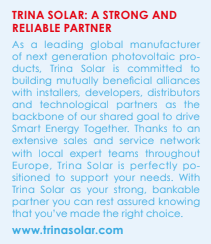 |
Sales ‘Blurb’. The first page will always include some reasons to choose either the manufacturer or the panel, or both. See our Best Solar Panels page to understand more about which panel to choose. |
In the case of the Trina panel, the rest of Page 1 is given over to the key selling points. Here, Trina has chosen to major on the low light performance, aesthetics, quality control and environmental performance, as well as the warranty.
 |
The best way to test these claims and to compare low light performance between panels is to carry out an hour-by-hour simulation of panel performance using simulation software such as PVSOL. Historical solar radiation data and the full system parameters can be used to generate the expected hourly system output. You can also look at the I-V curve (see below). |
 |
Output: Watts per square metre is calculated by dividing the Maximum Power Output by the area of the panel. |
 |
Aesthetics matter and black is generally the desirable colour. If black is what you are looking for, see our page on black solar panels. |
 |
Lots of tests mentioned, but MCS Accreditation is actually the certification often required by specifiers in the UK. This is listed on Page 2. |
 |
Environmental parameters matter when it comes to structural considerations (can the panels take the expected forces from wind and snow?) and warranty issues. If you are using the panels on a boat, or installing by the sea, don’t just check the datasheet for ammonia and salt resistance, check the warranty as well. |
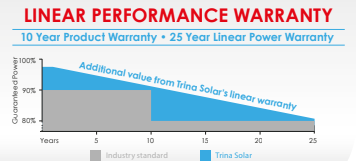 |
Warranty The standard panel warranty is a 10 year product (defects) warranty and a 25 year power warranty. The power warranty usually guarantees that the panels will output 90% of their initial power output after 10 years, and 80% of initial power output after 25 years. The warranty may be ‘stepped’ (grey shading in the picture) or linear (blue shading in the picture), linear being superior to ‘stepped’. Note that in the first year or two there is always an initial degradation in the solar cells, so even on day one, the warranty won’t guarantee 100% of the initial maximum power output. Note that modelling software such as PVSOL will take this degradation into account. Note also that SunPower gives a superior warranty to a standard panel – see below. |
Standard solar panel specification sheet: Page 2
Page 2 usually gives panel dimensions, and other mechanical data such as weight, details of the frame and of the glass covering the cells.
In addition Page 2 generally lists the panel certifications. For the Trina panel these are as follows:
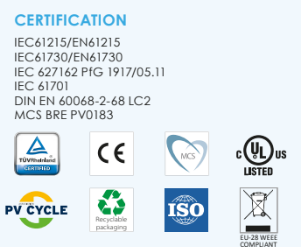
Note first the MCS number, MCS BRE PV0183. MCS stands for Microgeneration Certification Scheme – the UK scheme set up at the same time as the Feed-in Tariff subsidy, to guarantee consumers wishing to install panels and claim the tariff minimum standards of quality both from the solar panels they install and the installation company they use to install the panels. The Feed-in Tariff subsidy ended in March 2019, but the scheme continues. It is usually a requirement in commercial tenders that panels and installers are MCS approved.
Note also the PV Cycle logo. Under the WEEE Regulations retailers or installers selling photovoltaic (PV) panels to private households are classified as PV Distributors. As such, they must:
- have a procedure in place to take back PV waste or
- contribute towards a Government-approved Distributor Take-back Scheme to finance collections from local authority sites.
In the United Kingdom, PV CYCLE - the collective take-back and recycling scheme for PV panels - operates a PV-focused Producer Compliance Scheme as well as the only PV Distributor Take-back scheme, providing full compliance services under WEEE Regulations for UK-based PV businesses.
By joining PV CYCLE DTS, the PV Distributor becomes exempt from its requirement to offer a service directly through its premises and is compliant with the UK WEEE Regulations.
Page 2: Electrical data
The rest of Page 2 is given over to electrical data. The first thing to be aware of is the NOCT and the temperature ratings:
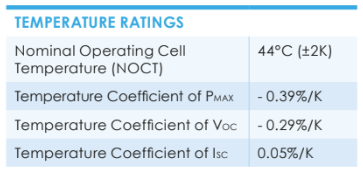
The Nominal Operating Cell Temperature (NOCT) is the temperature at which the cells work under irradiance of 800 Watts per square metre, at an ambient temperature of 20°C and a wind speed of 1 metre per second. For these Trina panels, the NOCT is 44°C. The temperature coefficient PMAX shows how much power is lost for every degree (Kelvin) increase in cell operating temperature. Note that solar cells perform better at lower temperatures, hence the loss in power as cell temperature rises. The coefficient of VOC gives the voltage drop that occurs with increase in cell operating temperature. The coefficient of ISC gives the change in current with increase in cell operating temperature.
Other key electrical data is as follows. Note that there are three columns, one for each of the different panels in the range: 265W, 270W, and 275W.

We have covered the Power Output Tolerance and Module Efficiency on Page 1. The other measurements are as follows:
The Open Circuit Voltage (Voc) gives the voltage of the solar panel with no load on it (and thus no current being produced). If you connect a voltmeter across the plus and minus leads, you will read you will read Voc. Voc represents the maximum voltage the panel can produce under standard test conditions, and determines how many panels can be wired in series going into an inverter.
The Short Circuit Current (Isc) gives the current (measured in amps) that the solar panels will produce when not connected to a load, but when the plus and minus of the panel wires are directly connected to each other (or via an ammeter to measure the current). This is the highest current the solar panels can produce under standard test conditions.
When looking at the other parameters (Pmax, Vmpp, Impp), it is helpful to consider the I-V curve on the datasheet.
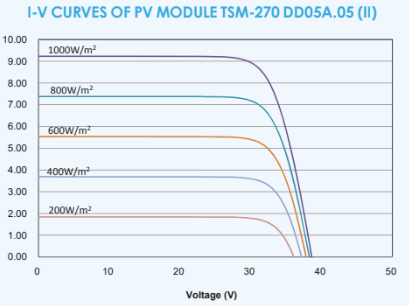
This graph shows how the current output by the panels varies with voltage, at various levels of irradiance. In this case, the bottom line is at 200W / m2 and the top line is at 1,000W / m2. For each curve, the ‘sweet spot’ is at the knee of the curve, where the volts and amps combine to give the highest wattage (Volts x Amps = Watts). This point is called Pmax, and the corresponding voltage and current that achieve Pmax are called Vmpp and Impp respectively.
When you use a Maximum Power Point Tracking (MPPT) charge controller or inverter, this is the point that the MPPT electronics tries to keep the volts and amps at to maximise the power output.
The wattage of the panel is given as Pmax, with Pmax = Vmpp x Impp.
High efficiency solar panel specification sheet: Key differences
If you look at the SunPower datasheet, you will see similar data, but with ‘better’ stats.
Key differences between the standard Trina panel and the SunPower panel are as follows:
- The panels in the SunPower range have an output of 370W, 390W or 400W, compared to 265W, 270W, or 275W for the Trina panels.
- Dimensions for the SunPower panels are 1,046mm x 1,690mm, compared to 941mm x 1,650mm for the Trina panels. So a modest increase in size with the SunPower panels, and a significant increase in output. This is of course down to efficiency.
- The maximum module efficiency is 22.6%, compared to 16.8% for the Trina panels.
- The SunPower panels have 104 cells, and thus an open circuit voltage of around 75V, (~ 0.7V per cell), compare to the Trina panels which have 60 cells and an open circuit voltage of around 38V (~0.6V per cell).
- The power temperature coefficient of the SunPower panels is -0.29%/K, compared to -0.39%/K for the Trina panels. Thus the Trina panels have a greater power degradation as cell operating temperature increases.
- The SunPower panels have a superior warranty, with a 25 year defects and performance warranty, and a guarantee that degradation will only be to 92% of initial output after 25 years, not 80%:
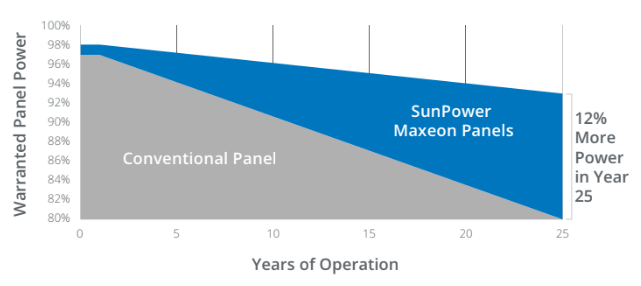
Choosing the right solar panels
It can be a tricky business picking the best solar panels for each project. Utilise our design skills and knowledge of the market to ensure you always get it right:




